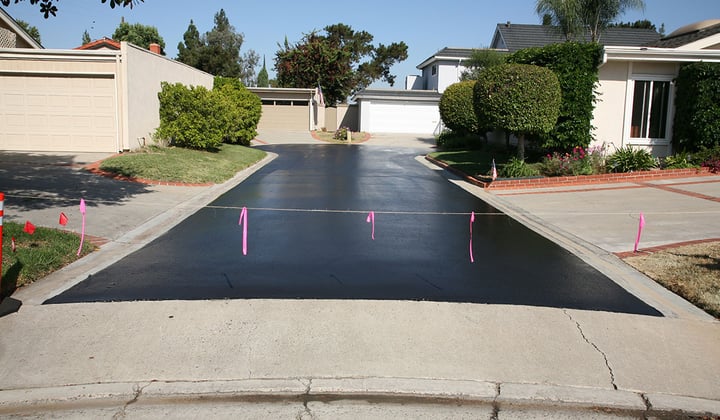Warm Mix Asphalt: A Lasting Service for Sidewalk
Warm Mix Asphalt (HMA) has arised as a leading lasting option for pavement remedies, supplying a myriad of ecological advantages and ingenious technologies. As the need for environmentally friendly building and construction methods grows, exploring the subtleties of HMA's sustainability can offer important understandings into the future of sidewalk remedies.
Ecological Benefits of Hot Mix Asphalt

Furthermore, Warm Mix Asphalt helps to alleviate city warmth island results. Its dark shade takes in sunshine, reducing the amount of warm reflected back right into the ambience contrasted to lighter-colored pavements. This can reduce ambient temperatures in city locations, decreasing the need for cooling and eventually reducing energy usage.
In enhancement, Hot Mix Asphalt contributes to improved stormwater monitoring. Its permeable nature permits water to charge and penetrate the pavement groundwater materials, reducing overflow and the danger of flooding. These ecological advantages make Hot Mix Asphalt a lasting option for paving roads and freeways.
Power Performance in HMA Manufacturing
Is power efficiency a vital aspect in the manufacturing of Warm Mix Asphalt (HMA)? Energy plays a considerable role in the production of HMA, influencing both cost and environmental sustainability. One vital aspect of energy efficiency in HMA production is the usage of warm mix asphalt (WMA) modern technologies.
Moreover, improvements in plant technologies have actually led to even more energy-efficient HMA production procedures. Modern plants are made with attributes like recycled asphalt pavement (RAP) processing capabilities, efficient heater systems, and improved insulation, all contributing to power cost savings. By optimizing power use in HMA production, the industry can decrease its carbon footprint while maintaining top notch pavement materials. Energy efficiency is, as a result, a vital consideration in guaranteeing the sustainability of Hot Mix Asphalt manufacturing.
Recyclability of Hot Mix Asphalt
The recyclability of Hot Mix Asphalt (HMA) is an essential facet of its sustainability and lasting ecological effect. HMA is one of the most recycled products in the United States, with over 100 million lots of recovered asphalt sidewalk (RAP) being recycled annually in new pavement building and construction. Recycling HMA offers numerous ecological benefits, such as reducing the demand for virgin products, reducing power usage during production, and reducing check out here the amount of waste sent out to garbage dumps.
The process of recycling HMA includes crushing the existing pavement, crushing it into smaller sized items, and blending it with new aggregate and asphalt binder to develop a recycled mix. On the whole, the recyclability of HMA plays a considerable function in promoting lasting techniques within the sidewalk market.

Long-Term Performance of HMA
Asphalt pavements demonstrate toughness and strength over an extended period, showing the long-lasting efficiency of Warm Mix Asphalt (HMA) The longevity of HMA can be associated to its capacity to hold up against heavy traffic lots, severe weather, and the impacts of aging. Research studies have revealed that well-designed and effectively created HMA sidewalks can last for visit their website twenty years or more with regular upkeep. The secret to optimizing the lasting performance of HMA hinges on making use of top quality materials, following best methods in building, and implementing effective upkeep techniques. Proper water drainage, routine inspections, and timely fixings are important for protecting the architectural stability of HMA pavements gradually. Additionally, developments in HMA modern technology, such as making use of polymer-modified binders and warm mix asphalt, have even more enhanced the durability and durability of HMA pavements. By prioritizing top quality building and construction and upkeep techniques, HMA remains to prove itself as a sustainable and cost-efficient service for durable sidewalk framework.

HMA: Longevity and Sustainability
Demonstrating both toughness and sustainability, Warm Mix Asphalt (HMA) has actually ended up being a cornerstone in the building and construction of durable pavement facilities - hot mix asphalt. HMA's longevity originates from its capability to endure heavy loads, harsh climate condition, and high traffic quantities, making it a trusted selection for highways, freeways, and airport terminal paths. The composition of HMA, which generally includes aggregates, binder, and filler, plays an important function in boosting its durability and resistance to wear and tear
In addition, HMA's sustainability hinges on its recyclability and energy-efficient production procedure. The ability to reuse reclaimed asphalt sidewalk (RAP) in new HMA combinations minimizes the need for virgin materials and lessens the environmental effect of sidewalk construction and upkeep. Additionally, the power effectiveness of producing HMA hinges on its reduced blending temperatures contrasted to other pavement products, causing lowered power usage and greenhouse gas discharges.
Final Thought
To conclude, hot mix asphalt (HMA) provides a lasting solution for sidewalk with its environmentally pleasant attributes. HMA's recyclability, energy efficiency in manufacturing, and lasting longevity make it a green option for roadway building and construction. By preserving all-natural resources, reducing waste, and decreasing greenhouse gas discharges, HMA plays a crucial duty in look here advertising sustainability in framework development. Its ability to alleviate urban warmth island impacts further emphasizes its significance in producing resilient and environmentally aware pavement systems.
HMA is one of the most recycled products in the United States, with over 100 million tons of recovered asphalt pavement (RAP) being recycled every year in new sidewalk construction.The procedure of recycling HMA involves milling the existing pavement, squashing it into smaller sized items, and mixing it with brand-new aggregate and asphalt binder to develop a recycled mix.Asphalt pavements demonstrate resilience and strength over an extensive duration, mirroring the lasting efficiency of Hot Mix Asphalt (HMA) In addition, advancements in HMA technology, such as the use of polymer-modified binders and cozy mix asphalt, have additionally boosted the sturdiness and durability of HMA pavements. The capacity to reuse reclaimed asphalt sidewalk (RAP) in brand-new HMA mixes decreases the demand for virgin products and decreases the ecological impact of sidewalk building and upkeep.